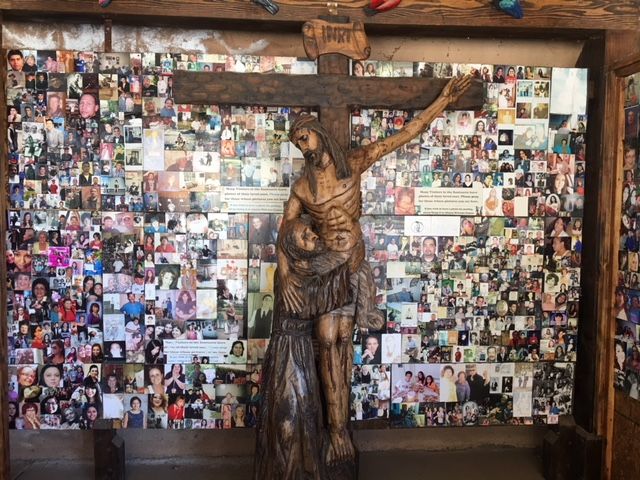Just a few miles outside Santa Fe is the Santuario ofrnChimayo, the Lourdes of America, and one of the more interesting pilgrimagernsites in the Unites States. It hosts about 300,000 visitors a year, about 10%rnof them during Holy Week.
At that time, it is traditional in this area to make arnpilgrimage to Chimayo and many pilgrims do so on foot. Walkers come from as farrnaway as Albuquerque and Taos, as close as from the nearby towns of Santa Cruzrnand Truchas. Most of the pilgrims arrive on Holy Thursday and Good Friday, but onrnthe Saturday before Palm Sunday, there were already walkers on the road, somernsolitary, some in groups. Some walk in thanksgiving for a miracle, some to askrnfor one, some as penance, some in solidarity with others. Almost all of themrncarry crosses, some large, some small, some plain, some elegant, some withrnpetitions attached, some unadorned. They will be left at the Santuario for allrnto see and remember, for the cross not only reminds pilgrims of their faith, itrnis tied to the particular history of this place.
A local friar—or a local settler, depending on which versionrnof the story you hear—who was doing penance in the area discovered a crucifixrnburied in the ground at the site. The crucifix, which still hangs in the church,rnbecame known as Nuestro Senor De Esquipulas, a Guatemalan devotion associatedrnwith miracles and healing. The current chapel was built in 1816, replacing anrnearlier structure.
By that time, there were already reports of miraculous curesrnthat eventually came to be associated with the ground in which the crucifix hadrnbeen discovered rather than the crucifix itself. To the side of the chapel is a small room inrnwhich pilgrims can remove dirt from the site. rnFew leave without at least a bit of the powdery red soil to take withrnthem. Ranks of crutches, testimonialrnnotes, and a variety of other objects give testimony to the number of healingsrnassociated with Chimayo.
 rn
rn
rn
The grounds contain a number of smaller shrines as well asrnan outdoor garden (containing not only Our Lady of Guadalupe but Our Lady of LarnVang, testimony to the fact that the Church makes room for all her children andrntheir particular devotions). An altar isrndecorated with Native American symbols. Along the walkway that leads from thernparking area to the main plaza, there is a shelter in which a crucifix with Christrnembracing St. Francis is surrounded by thousands of pictures brought there byrnpilgrims seeking intercession for healing or giving thanks for blessingsrnreceived. By the river are the Stationsrnof the Cross.
 rn
rn
rn
Nearby is the Church of El Santo Nino with its own shrine tornEl Santo Nino de Atocha. Because legend has it that El Santo Nino wore out hisrnshoes ministering to those in prison, a traditional token of thanksgiving is arnpair of baby shoes and the walls of the shrine are covered with them.
The power of a pilgrimage is great, making prayer involvernall of our person, body, mind and resources, and reminding us that faith, likernlife, is a journey. It is as universal as humankind and as particular as thernpeople who make it and the cultures from which they come.
As we journey through Holy Week, considerrnthis advice given by Fr. Julio Gonzales, pastor of the Santuario, to arnpenitent who wished to come to Chimayo to ask for healing of her niece:
First, start yourrnpilgrimage with prayer. In your prayer,rncall God your Father. He is actually waiting for you. Then acknowledge yourrnweaknesses and flaws. Entrust your deeper longings to him. Entrust your niecernto him. Ask the Lord to reveal his will to you during this pilgrimage. If yourncannot understand him, how can you be faithful to him? But remember, you canrnonly understand God with your heart, and this heart must be emptied before Godrnsends his grace on you. The pilgrimage will help you to empty your heart ofrnanything that is not of God.
Second, during thernpilgrimage, offer God your tiredness, hunger, suffering, pain. In the same wayrnthat Jesus his son suffered for us, tell God that the purpose of your sacrificernis your niece’s healing. You should fast… the purpose of fasting is not tornweaken your body but to strengthen your will and thus your body.
Third, but you don’t wantrnto tempt your God. Don’t act like Satan when Jesus went into the desert: if yournare the Son of God, do this, do that. Your prayer should be Jesus’ atrnGethsemane: not my will but yours.
Whether we are walking along the roads that lead to Chimayornor not, we are all on pilgrimage now, first to Calvary and then to the joy ofrnthe Resurrection.
Let us walk together.
Barbara Golder had a 40-year career in medicine and law, including health care ethics. She is now the award-winning author of the ‘Lady Doc’ mystery series and serves as Director of Adult Faith Formation and Evangelization at the Basilica of Sts. Peter and Paul in Chattanooga, Tennessee. She blogs at ladydoclawyer.com.

